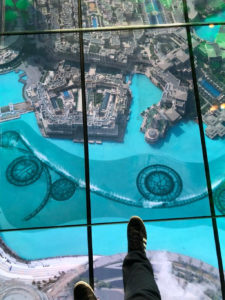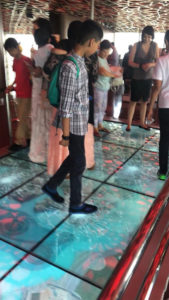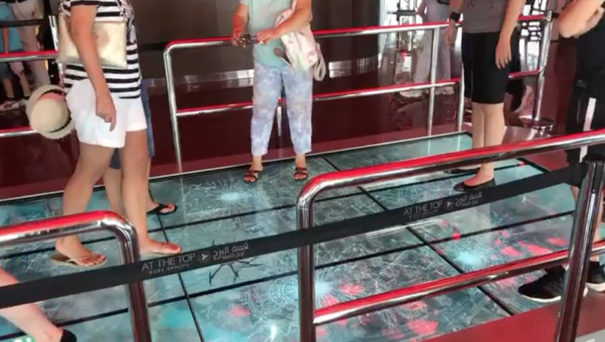El Burj Khalifa crea una nueva atracción de realidad virtual en el piso 125
Se ha creado un suelo interactivo que simula que se va agrietando según se pisa. Para su realización se han utilizado 18 pantallas LG OLED 8K de 55 inches, dos reproductores BrightSign XT1144 y 15 sensores Nexmosphere XDW-M44.
BrightSign, DigiComm y LG han colaborado para realizar una nueva atracción de realidad virtual inmersiva en el piso 125 del emblemático Burj Khalifa de Dubai.
Con 160 pisos y más de 828 meters high, el rascacielos ha estado cautivando a los visitantes durante casi diez años. Además de las impresionantes vistas, que se ofrecen desde la plataforma de observación exterior más alta del mundo, y un crucero de alta velocidad en el ascensor más lejano del planeta, los buscadores de emociones pueden experimentar la escalada por el exterior de la estructura y el paracaidismo desde la cima gracias a una simulación de realidad virtual inmersiva.
 Los propietarios de la torre, Emaar Properties, buscaban crear una nueva y sensacional atracción en el piso 125 del edificio conocido como ‘At the Top’, que recibe alrededor de 10.000 visitantes al día. Junto a LG, se ha creado una simulación interactiva y realista de un piso de vidrio sobre la ciudad que parece agrietarse al ser pisado.
Los propietarios de la torre, Emaar Properties, buscaban crear una nueva y sensacional atracción en el piso 125 del edificio conocido como ‘At the Top’, que recibe alrededor de 10.000 visitantes al día. Junto a LG, se ha creado una simulación interactiva y realista de un piso de vidrio sobre la ciudad que parece agrietarse al ser pisado.
“Querían algo realmente espectacular y muy entretenido”, explica Abdul Bakhrani, CEO Dubai-based digital media studio and systems integrator de DigiComm, y responsable de los contenidos, medios y efectos especiales de la atracción, así como de otras instalaciones dentro del edificio, incluida la experiencia de realidad virtual.
Para la realización de este ‘suelo interactivo’ se han utilizado 18 pantallas LG OLED 8K de 55 inches, construidas con cristal endurecido extremadamente duradero; así como dos reproductores de E/S expandidas BrightSign XT1144. Las pantallas muestran una animación visual de gran realismo de la ciudad, a 456 metros de profundidad, que cambia según la hora del día y la estación. El contenido es programado y controlado por los reproductores de BrightSign.
 En la instalación también se utilizan 15 sensores Nexmosphere XDW-M44, de los que siete están conectados a un sistema XM-350 Xperience Controller que se conectan a los reproductores multimedia XT1144.
En la instalación también se utilizan 15 sensores Nexmosphere XDW-M44, de los que siete están conectados a un sistema XM-350 Xperience Controller que se conectan a los reproductores multimedia XT1144.
Cuando un visitante activa un sensor, se empieza a formar una grieta virtual en el suelo del skywalk y se intensifica. A medida que siguen caminando, el cristal se agrieta bajo de ellos. Los gráficos CGI de alta resolución, combinados con el audio sincronizado, dan como resultado una emocionante sensación de que el suelo se va agrietando a 125 pisos sobre el suelo.
Según Bakhrani, usar las pantallas OLED de esta manera era algo nuevo, y desplegar sensores de movimiento con tantos miles de personas también era un desafío. “Hizo falta bastante ensayo y error para conseguir la configuración correcta. Nosotros mismos no sabíamos cómo funcionaría con un número tan grande de visitantes. Estábamos probando las aguas, recogiendo información y mejorando constantemente. Nos tomó cerca de dos semanas conseguir el efecto deseado”.
Los reproductores de BrightSign fueron seleccionados porque son muy robustos, técnicamente viables y rentables. “El requisito era que pudieran ser desplegados y luego dejados para que funcionaran las 24 horas del día con un mínimo de gestión”, explica Bakhrani.
No se prevé que el contenido de los medios de comunicación cambie durante algún tiempo, ya que la exposición es muy popular y eficaz y la mayoría de los visitantes son turistas que sólo vienen una vez al Burj Khalifa. “Es muy realista. Algunas personas piensan que es real y se sienten asustadas.
LG, BrightSign y DigiComm han colaborado anteriormente en otros proyectos, incluyendo una experiencia con tiburones en el Acuario y el Zoológico Submarino de Dubai, que combina la tecnología digital con peces vivos.
Did you like this article?
Subscribe to our NEWSLETTER and you won't miss anything.



